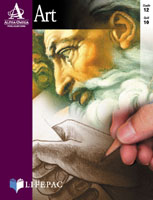
Lifepac Elective -- Art
From Alpha Omega Publications
Review by Martha Robinson
LifePac Electives -- Art by Keith Rosko and Karen Eubanks, $49.95. Please support HomeschoolChristian.com by using our Christian Book Distributors link or our direct link to Alpha Omega Publications.
The LifePac Art program, including ten workbooks and a spiral-bound teacher's guide, offers art theory, application, and appreciation. It is self-directed, so the parent's primary effort will be in assuring successful completion of tasks. Each of the components is discussed below.
Teacher's Guide -- The guide begins with a general overview of how to schedule homeschooling using LifePacs. Then, the authors discuss the importance of studying art and how students with an art background score higher on standardized tests. They mention the national standards of art, addressing art history, criticism, studio activities, and connecting art to other subjects, as guiding points for the program. Supplemental resources including books, materials, and Web sites are listed.
The guide next goes through each LifePac with a brief listing of "Adult Checks," specifically what the parent should look for in each activity. Answers to worksheets and a large number of supplemental activities, along with additional information on techniques and artists, appear. Forms and instructions for the parent to use in evaluating the student's art offer the parent an opportunity to model tactful feedback and encourage the youth. Alternate tests for each LifePac and an answer key for all tests make up the remainder of the teacher's guide.
Each LifePac has a unit test bound into the middle of the book. The parent may wish to remove these before giving the program to the student.
LifePac 1 -- Concepts in Design -- This unit covers a large amount of vocabulary such as line, texture, value, color, symmetry, movement, and rhythm. Some of the activities involve cutting and pasting pictures from magazines into the workbook, but other activities have the student working with tangrams, string art, drawing, and cutting construction paper in a mirror-image design.
LifePac 2 -- Principles of Color -- A list of materials needed (paints, brushes, mixing trays, and palette paper) begins this unit with "good" and "bad" brushes pictured. Then a definition of the technical aspects of color, along with an explanation of Sir Isaac Newton's discovery on the spectrum, follows. The more standard color wheel discussions and activities come next. Later, the effects of complementary colors on your eyes and the behavioral effects of colors are discussed.
LifePac 3 -- Design Personality -- Unit 3 gives the student an introduction to communicating with others through art. The lessons begin with analog drawings, or how mood can be shown with color and shape. In the idea generation section, the authors cover an incredible amount of material ranging from designs in nature to optical art and patterns from other countries.
LifePac 4 -- Perspective -- Many aspects of perspective are covered here including vanishing lines, grid drawing, and two point perspective. Showing depth in figures such as cylinders and spheres is another topic.
LifePac 5 -- Figure Drawing -- The entire unit is dedicated to the drawing of the human body. Proportion and shading of the face are the first two topics, with a brief unit on the entire body finishing the unit.
LifePac 6 -- Sculpture -- Examples of classic and modern art illustrate the three forms of sculpture: in-the-round, relief, and intaglio. Projects include a mobile, a three-dimensional collage in a box, and a casting activity with clay or plaster.
LifePac 7 -- Comics -- This unit begins with a discussion of the history of comics and its importance in advertising, illustrations, and animation. Many techniques and tips for basic figures, action shots, and word balloons follow. The final project is to create a comic strip, and the example comic of David and Goliath shows the student that biblical application of this skill is possible.
LifePac 8 -- Printmaking --Pointing out that most fine artists make their livings with prints and posters, the authors outline a brief history of printmaking and follow with projects for stencils, relief, mono-, and intaglio printing. A particularly interesting activity is making a print of a spiderweb.
LifePac 9-- Calligraphy -- Variations of the Roman and Uncial scripts are provided for the student to model as he letters a Bible passage.
LifePac 10 -- Art Appreciation -- Very brief overviews of eighteenth through twentieth century art movements; and the art forms of painting, sculpture, architecture, and commercial art are the topics in the final LifePac.
Recommendation: The LifePac Art program offers a wide-ranging overview of art techniques and forms that is bound to spark interest. The huge quantity of terms introduced will provide a foundation for further study in the forms that most appeal to the student. Because of the nature of this program, the quantity of workbook questions is lower, and stimulating projects serve for learning activities.
This program could easily be used by the motivated junior high school level student with little parental participation required. Yet, with some more in-depth study and field trips, the LifePac Art program could provide a challenging full year of high school work.
HomeschoolChristian.com resources related to this review:
HomeschoolChristian.com's Art Page for many ideas for teaching art!
Review of Art Games
Review of Art Masters
Review of Atelier
Review of Come Look With Me
Review of Calvert's Discovering Art
Review of Drawing Basics with Thomas Kinkade
Review of Drawing Breakthrough Book
Review of Paint By Grids
Review of Teaching Geography Through Art
Find more helpful reviews on HomeschoolChristian.com's Review Page Index!
Reviews represent the opinions of the authors rather than the views of HomeschoolChristian.com.



